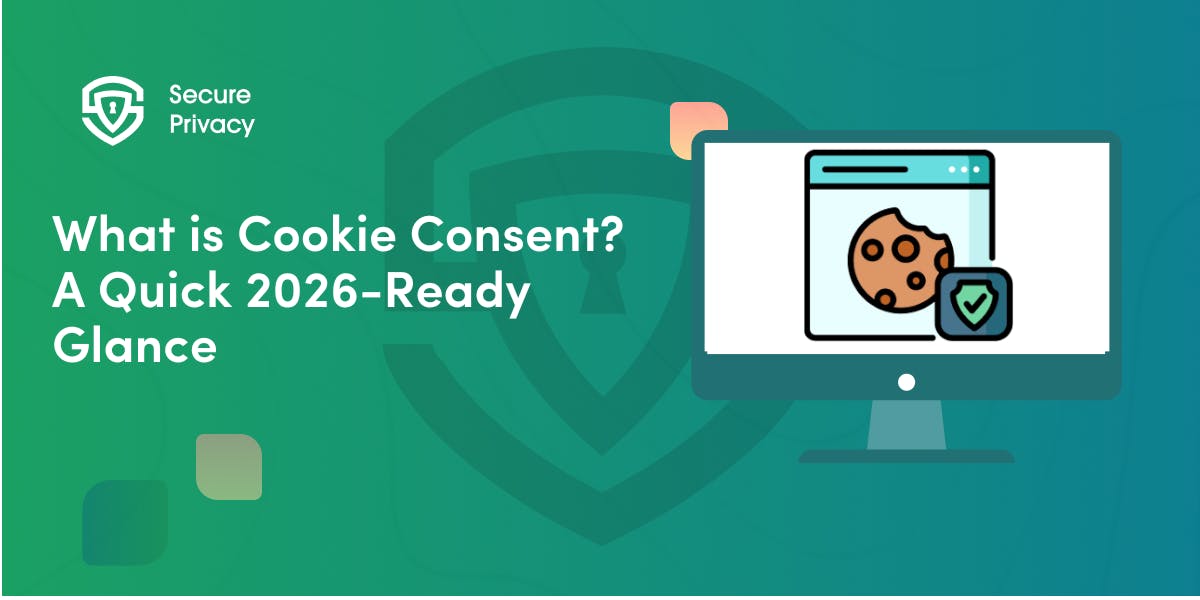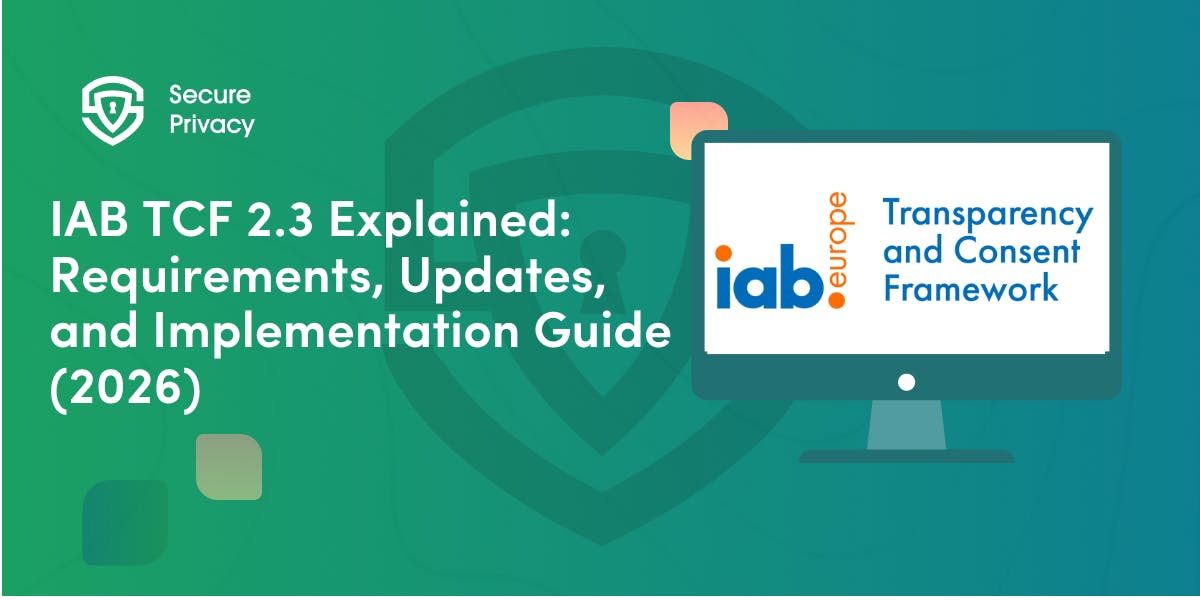The Psychology Behind Cookie Consent: Why Users Click "Accept"
You notice the pattern right away when looking at your website data. Even though more people care about privacy, 85% of visitors still click "Accept All" on your banner within seconds. This seems to contradict survey data showing that 78% of people worry about online privacy and data collection.
Cookie consent psychology shows the complex relationship between how people think, interface design, and legal rules that drives these confusing decisions. Understanding these mental processes helps organizations create experiences that respect independence while keeping necessary data collection abilities.
This complete analysis looks at the behavioral science behind decisions and gives useful strategies for designing ethical, compliant systems that build long-term trust.

Prioritizing user privacy is essential. Secure Privacy's free Privacy by Design Checklist helps you integrate privacy considerations into your development and data management processes.
The Behavioral Science of Consent Decisions
Interactions happen in milliseconds, using mental processes that skip careful thinking about privacy concerns. Research shows that most people use Type 1 thinking for decisions, relying on mental shortcuts and feelings rather than careful analysis of privacy trade-offs.
Modern cognitive load theory explains why people struggle with meaningful evaluation. Website visitors usually come with specific goals while handling limited attention across multiple information sources. Banners interrupt these main tasks, creating mental conflict between immediate goals and privacy protection needs.
Decision shortcuts become inevitable when people face repetitive requests across dozens of websites daily. The average internet visitor sees 15-20 banners per browsing session, creating systematic decision fatigue that hurts thoughtful privacy consideration regardless of individual preferences or technical knowledge.
Dark Patterns vs Ethical Design in Cookie Banners
Manipulative design patterns exploit fundamental cognitive biases to steer people toward data collection acceptance without genuine understanding or choice. These dark patterns in cookie banners violate both regulatory requirements and ethical design principles while creating long-term trust erosion that damages brand relationships.
Visual Hierarchy Manipulation and Interface Coercion
Research analyzing over 10,000 implementations reveals that 72% contain at least one dark pattern designed to increase acceptance rates through visual manipulation. Common techniques include making "Accept All" buttons significantly larger, brighter, or more prominently positioned than rejection alternatives.
Color psychology plays a crucial role in manipulation. Studies show that using green for acceptance buttons and red for rejection options can increase rates by 23% compared to neutral color schemes. These design choices exploit learned associations between color and action while bypassing conscious decision-making processes.
Friction asymmetry represents another widespread manipulation technique. Organizations deliberately create barriers to rejecting while making acceptance effortless through single-click processes. This approach exploits the path of least resistance principle, where people default to acceptance to minimize cognitive effort required for task completion.
Pre-Selection Bias and Default Setting Exploitation
Pre-checked boxes violate GDPR requirements while exploiting status quo bias, where people tend to maintain default settings rather than actively modifying them. Behavioral research demonstrates that default settings can influence choices by 50-70%, making them powerful tools for manipulation when misused.
Misleading framing techniques use emotional manipulation or false dichotomies to pressure people into agreement. Examples include suggesting that website functionality will be severely impaired if rejected, when only essential elements are actually required for basic operation and experience.
Privacy Nudges and Ethical Behavioral Design
Ethical applications of behavioral design and consent psychology can guide people toward informed privacy decisions while preserving autonomy and choice. These privacy nudges represent responsible implementation of psychological insights that support rather than undermine agency in digital privacy contexts.
Empowering Decision-Making
Privacy-protective default settings can be designed to protect privacy by default while requiring active agreement only for non-essential tracking activities. Carnegie Mellon University research demonstrates that privacy-protective defaults significantly reduce unnecessary data disclosure while maintaining satisfaction and website functionality.
Information architecture improvements include presenting categories with clear explanations of actual data use, implementing progressive disclosure for complex privacy choices, and providing easily accessible management tools throughout the journey. These approaches respect cognitive limitations while enabling informed decision-making.
Social influence nudges can leverage positive social norms around privacy protection by displaying accurate information about how other people have chosen privacy-protective settings. However, these techniques must be implemented transparently to avoid manipulation while providing genuine social proof rather than fabricated statistics.
Timing and Context Optimization
Machine learning algorithms can help identify optimal moments for requests based on engagement patterns, device capabilities, and contextual factors. Research shows that presenting choices during natural task completion points reduces interruption while improving consideration quality.
Adaptive systems reduce cookie behavior friction by learning from preferences across sessions while maintaining granular control options. These systems can minimize repetitive requests while ensuring compliance with evolving privacy preferences and regulatory requirements.
GDPR Cookie Consent Psychology and Regulatory Requirements
GDPR cookie consent psychology must satisfy specific behavioral principles to achieve legal validity while respecting human cognitive limitations. Understanding these requirements reveals how regulatory frameworks intersect with behavioral psychology to create enforceable privacy protection standards.
The Four Pillars of Psychologically Valid Consent
Freely given agreement requires people to have genuine choice without coercion, bundling with other terms, or manipulative design elements. This requirement directly conflicts with dark patterns that use pressure tactics or make rejection artificially difficult through interface manipulation or emotional coercion.
Specific agreement demands separate authorization for different data processing purposes, preventing blanket permissions that people cannot meaningfully evaluate. This granularity supports informed decision-making by allowing people to consider each data use individually while accommodating varying comfort levels with different tracking activities.
Informed agreement mandates clear information about data collection purposes, retention periods, sharing arrangements, and rights. The psychological challenge involves presenting this information in formats that people can understand and process effectively without creating overwhelming cognitive burden.
Unambiguous agreement requires clear affirmative action, ruling out pre-checked boxes, continued website use, or other implied mechanisms. This principle recognizes that meaningful agreement requires deliberate choice rather than passive acceptance through inaction or interface manipulation.
Research on Quality and Behavior
European research examining GDPR implementation reveals significant gaps between regulatory intent and actual experience. Analysis of interfaces across multiple countries found that people spend minimal time reading notices, often less than 10 seconds, yet make decisions with long-term privacy implications that affect years of data processing.
Studies measuring quality demonstrate that interface design can override individual privacy preferences even among privacy-aware people. When websites made rejecting more difficult through multi-step processes or confusing language, acceptance rates increased dramatically regardless of participants' stated privacy concerns or technical knowledge levels.
Fatigue and Experience Challenges
Fatigue represents one of the most significant unintended consequences of privacy regulation implementation. This phenomenon occurs when people become overwhelmed by repetitive requests, leading to disengagement from meaningful privacy decision-making and automatic acceptance of tracking permissions.
Psychological Mechanisms Behind Decision Exhaustion
Decision fatigue results from cognitive depletion that occurs when people face numerous sequential privacy choices across multiple websites and applications. Neurological research suggests that the brain's dorsolateral prefrontal cortex, responsible for complex decision-making, becomes less active after repeated requests within short time periods.
Habituation causes people to develop automated responses to prompts, essentially developing blindness to privacy information presentation. This behavioral adaptation protects people from cognitive overload but undermines the informed consideration that privacy regulations aim to promote across digital interactions.
Cultural and Regional Variations
User decision-making online varies significantly across cultural and demographic boundaries, with important implications for global privacy design strategies and interface optimization. These variations reflect different cultural attitudes toward privacy, authority, and technology adoption patterns.
Cross-Cultural Privacy Attitudes and Behavior
Research reveals substantial variations in privacy attitudes and behavior across different cultural contexts. Asian visitors generally show higher tolerance for implicit defaults and data sharing arrangements compared to European visitors who demonstrate greater sensitivity to granular controls and explicit opt-in requirements.
American visitors typically fall between these cultural extremes, with significant regional variation based on state-level privacy regulations and local privacy advocacy efforts. Cultural factors influence not just rates but also the types of information people consider most sensitive and worthy of protection.
Age and digital literacy effects create additional complexity in psychology. Younger people demonstrate less automatic acceptance but also show different patterns of engagement with interfaces. Older people may struggle with complex interfaces but demonstrate greater willingness to read privacy information when presented clearly and concisely.
Business Impact on Data Collection
Understanding psychology provides strategic advantages for organizations seeking to balance privacy compliance, trust, and data collection objectives. Research demonstrates clear connections between design choices and both immediate opt-in rates and long-term customer relationship quality.
Short-Term Data Collection vs Long-Term Trust Building
Organizations using dark patterns often achieve higher immediate data collection rates but experience decreased trust, increased privacy tool adoption, and higher customer churn rates over time. Studies show that 81% of consumers consider trust a key factor in purchasing decisions, making ethical design a competitive advantage.
Transparent processes that prioritize autonomy consistently generate higher quality first-party data while building sustainable customer relationships. People who feel respected in privacy interactions demonstrate increased engagement, higher lifetime value, and greater willingness to share additional information through explicit value exchanges.
Data quality metrics reveal that people who actively choose to share data through ethical processes provide more accurate information and engage more authentically with personalized experiences compared to those who passively accept tracking through manipulative interfaces.
Designing Psychologically Sound Systems
Creating effective systems requires integrating legal compliance requirements with psychological insights about human decision-making and interface design principles. Best practices emerge from research on both successful implementations and problematic experiences.
Equal Prominence and Visual Fairness
Ethical design ensures that accept and reject options receive identical visual treatment including size, color, contrast, and positioning. This prevents visual manipulation while maintaining genuine choice and regulatory compliance across different cultural contexts and preferences.
Clear language implementations avoid legal jargon and technical terminology in favor of plain language explanations that people can understand regardless of their technical background or privacy knowledge level. Terms like "essential" should be explained in concrete terms that relate directly to experience rather than abstract technical functions.
Technology Solutions for Management
Adaptive algorithms use behavioral analytics to optimize the timing and presentation of requests based on engagement patterns, device capabilities, and contextual factors. These systems can reduce interruptions while ensuring necessary permissions are obtained through respectful interaction design.
Federated privacy preferences allow people to set privacy preferences once and apply them across multiple websites through standardized protocols. This approach reduces repetitive requests while maintaining granular control and supporting evolving privacy preferences over time.
Regulatory Enforcement and Industry Evolution
Privacy authorities increasingly focus on the behavioral aspects of design rather than just technical compliance with regulatory text. This shift reflects growing regulatory sophistication in understanding behavioral manipulation and its impact on genuine agreement.
Recent enforcement actions against organizations using manipulative interfaces demonstrate that behavioral design decisions carry significant legal and financial risks. Major penalties often involve mechanisms that failed to provide people with genuine choice through interface design or interaction patterns.
The European Union's Digital Fairness Act represents the next evolution in regulating manipulative design practices. This legislation specifically targets dark patterns in digital interfaces while providing more explicit prohibitions against behavioral manipulation techniques commonly found in systems.
Best Practices for Ethical Design
Organizations implementing ethical informed consent design should prioritize autonomy and transparent privacy practices while maintaining necessary business functionality. These approaches build sustainable competitive advantages through enhanced trust and reduced regulatory risk exposure.
Essential Design Principles:
- ✅ Equal visual prominence for accept and reject options without manipulative design elements
- ✅ Clear, jargon-free language that explains data use in concrete terms
- ✅ Granular control options that respect preferences without overwhelming complexity
- ✅ Persistent access methods for people to modify choices over time
- ✅ Adaptive timing systems that respect context and cognitive resources
- ✅ Cross-platform consistency that maintains preferences across different interactions
Research demonstrates that organizations prioritizing ethical design achieve better long-term business outcomes through increased trust, higher quality data collection, and reduced regulatory compliance risks. These approaches represent strategic investments in sustainable customer relationships rather than short-term data collection optimization.
Get Started For Free with the
#1 Cookie Consent Platform.
No credit card required

What is Cookie Consent? A Quick 2026-Ready Glance
Your website loads. Cookies track users. But without proper cookie consent, you're violating GDPR — risking fines up to €20 million or 4% of global revenue. Cookie consent is the legally required mechanism by which websites obtain explicit user approval before deploying non-essential tracking technologies. This requirement stems from GDPR Article 4(11) and the ePrivacy Directive, mandating that consent must be freely given, specific, informed, and unambiguous.
- Legal & News

DSAR Tools Explained: Best Software for Automating Privacy Requests
You're drowning in data subject access requests. Manual searches through dozens of systems miss regulatory deadlines and expose organizations to fines starting at $2,500 per violation. The solution? DSAR tools — purpose-built software that automates the entire process of responding to data subject access requests, from intake to delivery.
- Legal & News

IAB TCF 2.3 Explained: Requirements, Updates, and Implementation Guide (2026)
Your ad revenue dropped 40% overnight. Google stopped bidding on your inventory. Your DSP partners flagged your traffic as non-compliant. The culprit? An outdated TCF 2.2 consent string after the February 2026 enforcement deadline.
- Legal & News
- Cookie Consent
